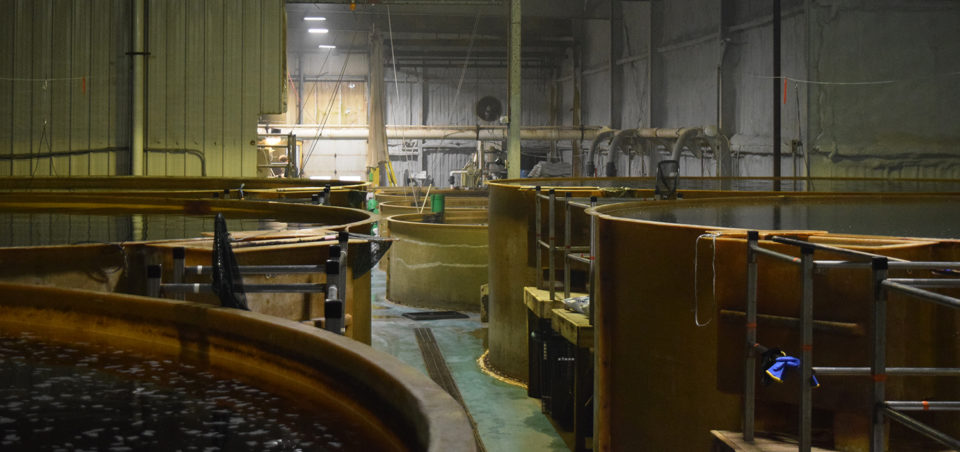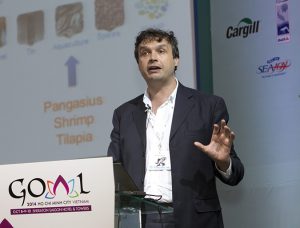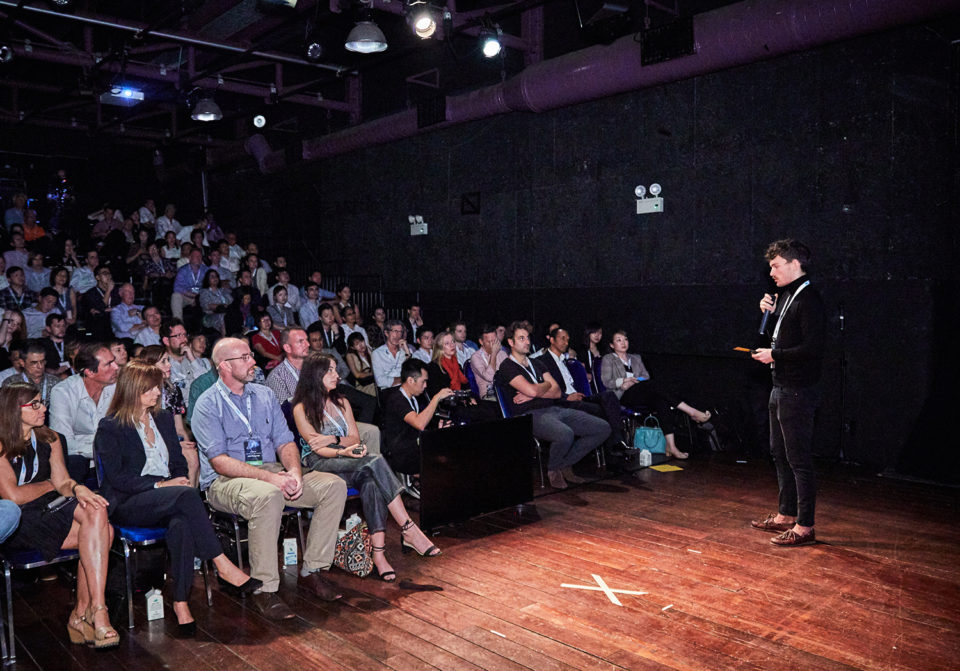Amid the massive disruptions brought on by the COVID-19 outbreak, innovations and new technologies could take a step forward

It didn’t make the nightly news, but Great Falls Aquaculture in western Massachusetts, USA, might have been the first seafood victim of the coronavirus (COVID-19) pandemic in the United States.
Most of the fish being raised in the company’s recirculating aquaculture system (RAS) facility in rural Turners Falls, Mass., are sold to live markets in major U.S. and Canadian cities, like New York, Boston, Toronto and Vancouver. The fish are typically raised to about 1 pound in size, perfect for whole-roasted individual servings.
Don’t worry – the fish are all alive and safe. But the fact that they’re all still in the tanks is a problem. Shortly after Chinese New Year celebrations in late January, the market for live barramundi (Lates calcarifer), known as the Asian sea bass, simply up and vanished.
“We were in contact with our Chinese customers on a daily business. Things were slowing down, family members weren’t coming home, they weren’t buying as much. They were nervous,” company owner Keith Wilda told the Advocate in late March. “Then, second week of February, people stopped going to Chinese restaurants in New York City.”
Great Falls was selling 23,000 pounds of barramundi per week before the COVID-19 outbreak. “Next week, I don’t know that I’ll even sell a fish,” he said, with 945,000 hungry barramundi currently swimming in indoor tanks. It’s a living inventory that reminds him of the tens of thousands of dollars it costs each month to operate, in energy and heating costs alone.
Wilda immediately switched from sell to survival mode, first by reducing the temperature of the culture water in the tanks by 1.5 degrees-C, a move aimed at slowing the fish’s metabolism and reducing their appetites. The results were immediate – daily feed rations dropped from 2,100 kg per day to 1,600 kg. The staff is carefully grading the fish by size more regularly to prioritize their needs, and to keep as many alive as possible until the market returns.
“It’s a stop-gap measure,” he admitted. “We’re maintaining, not necessarily trying to grow. The smaller ones you need to keep feeding or they’ll get cannibalistic.”
With electricity and heating bills for his RAS facility – the largest in full operation in the country – exceeding $35,000 per month, Wilda hopes the market disruption won’t last long, or the impact on his business (which he bought from Australis Aquaculture in 2018) will be significant. This all comes at a time when the company is investing in renewable energy solutions – including an anaerobic digestor in site – to make the plant more sustainable. Those plans are still advancing, but at a much slower pace than he’d hoped.
“Every fish you don’t sell really hurts,” he said.
Data to stop disease
Flavio Corsin, aquaculture director at IDH, the Dutch Sustainable Trade Initiative based in Utrecht, the Netherlands, is a veterinary epidemiologist by training. The worst animal diseases he encountered were foot-and-mouth disease on U.K. livestock farms and the white spot disease on shrimp farms in Southeast Asia. As epidemiology is the study of diseases across populations, Corsin has been watching the coronavirus crisis unfold with great interest, while hoping aquaculture can learn a lesson in the process.
“Coronavirus can create a common language,” he said. “Understanding the spread, the factors that allow the spread, will allow us to create a common language [to fight it]. Bugs are extremely versatile, quick to adapt and jump between species. They are designed to change. And you see, there’s always going to be a new bug.”

Over the years, Corsin said he’s seen a “trickling down” of technologies from human to veterinary epidemiology. The pace of this movement should accelerate with the heightened focus on preventative measures, diagnostics and novel solutions in the age of COVID-19, he believes.
Very few countries around the world are prepared for an outbreak, he added, due to poor allocation of resources, among other factors. The current pandemic should force aquaculture stakeholders of all levels to pay greater attention to biosecurity, he said, and in a far more collaborative way. Basic “syndromic surveillance” is one way in which producers of a given region can make a difference now.
It requires observance, recording and sharing: “Look for the signs. What is the average production in this cycle, in a certain province in Thailand, for example? What is normal? By understanding what normality is, you can identify when something is abnormal. If you have a shrimp that’s striped with yellow lines, you’ll recognize it as something that affects growth and survival. It could be a new bug, and if so, how do we identify it? That requires data. Collecting basic data and making that available to farmers is the first step.”
Corsin points to Norway as the only region of the world that practices aquaculture as having a grip on such a system in which all producers in the country can contribute and benefit.
“Norway has a lot of things they didn’t develop because they are rich,” he said. “The industry is more consolidated and organized, with fewer sectors to worry about. It’s more their willingness to recognize that you need a system based on data.”
IDH is currently working in several countries to develop systems in which data and epidemiological expertise are ingrained into normal, everyday practices. This type of work may get a boost, thanks partly to the coronavirus and the impact that a disease outbreak can have on business, whether it’s infecting humans or animals.
Aquaculture – particularly shrimp farming, Corsin’s area of expertise – has faced devastating disease outbreaks before, and quite recently. He sees the massive disruptions to supply chains improving in the short term, and that many farmers will survive, and even thrive, despite the current bleak outlook. But for long term survival there simply must be a greater emphasis on preventing aquatic diseases, as “every country is susceptible.”
“It’s not a matter of resources; it’s about the development of a system,” he stressed, agreeing that this shared moment is indeed a wake-up call. “There will always be a need for food. The funny thing is, if you have good data system, it makes the [production] systems more investable. They will have a track record that makes them bankable.”

New technology uptake
Hatch – the aquaculture business accelerator that’s funneling innovative startup companies into the space at a rapid pace – got a little bit fortunate in February when it closed its $8.4 million aquaculture-focused investment firm just before the start of the coronavirus crisis. Co-founder Georg Baunach stressed that all of the investors in the fund are fully committed.
“But one or two weeks later, we might have gotten into trouble,” he said.
What might still be impacted is the accelerator’s next cohort, scheduled to commence its immersive mentoring program – and the associated hard-driving schedule with global travel – in August.
“We’ll make the call by the end of May whether we will run the program as planned,” he said. “If that’s not possible, we would switch to a remote program.”
Baunach said many of the startup companies in the Hatch portfolio are naturally facing some difficulties with the disruption of supply chains and volatility in the marketplace, particularly with shrimp, over the past several weeks. But those in the pre-commercialization stage are less impacted.
“In terms of raising money right now, it’s more challenging. Liquidity will be an issue over the next months and years. It can be expected that money will dry up, to an extent. The pool is not as big as it was,” he said. “Startups need to manage money a little differently. Early-revenue streams, rather than take a big shot, will stay leaner and grow slower. Those are the considerations.”
https://www.aquaculturealliance.org/advocate/how-can-norway-defeat-pancreatic-disease-in-salmon-by-detecting-it-faster/
Disease-related diagnostic tools now emerging should find themselves a ready audience, he said. “Those things, to me, were already a winner before. Real-time, cheap diagnostic tools, that can [address] multiple species at once – we were looking for that already.”
What will undoubtedly change in and after the age of the coronavirus, said Baunach, is the adoption rate of new technologies, particularly if farming companies are going to be hit badly.
“The positive to come out of this is the awareness of the need for prevention and testing, and telling the difference between asymptomatic and symptomatic infections,” he said. And if solutions are presented in a more “obvious” way to the ordinary farmer, uptake will increase.
Baunach also sees more localized supply chains emerging as a risk mitigation strategy for seafood buyers – and for suppliers who have seen their customer base evaporate overnight. And alternatives or replacements being adopted today – say plant-based meat substitutes or even canned seafood – could potentially stick around longer. In sum, it’s not the worst time to be in the food industry.
“On the technology side, the development side, it might shift a bit. And some [investors] might go away from agri-markets for a while. But generally, we will come out of this with a better sense of the technologies needed for diagnostics,” he said. “Our portfolio is still in the business of food production. People are still going to eat. But things deemed not as essential, or as close to the basic needs of humans, will have tougher times.”

A bigger factor
With the live seafood market in urban U.S. markets in hibernation, Great Falls Aquaculture launched an online store to facilitate the sale of whole fish and a limited amount of fresh fillets, which are processed by a company in neighboring Rhode Island. They’re also looking for IQF (individually quick-frozen) equipment to broaden their product offerings for at-home cooks. The company owner is also exploring relief options for small businesses, and doesn’t sound like a man ready to back down.
“We’re still considered small, even with the largest recirc facility in the country right now,” said Wilda, who steadfastly defends RAS technology, despite high initial costs and operational costs.
“This is the time where recirculation systems are going to become a more important factor in our food systems,” he said. “We have greater traceability and biosecurity. We can account for almost every second of the fish’s life. We have control of all the inputs, all the advantages. It’s why I’m still in the business – I could have gotten out 20 years ago.”
Investment in the farm will continue, but on a new timetable. Wilda vows that the anaerobic digestor in the works – a 250-gallon manure holding system that could significantly reduce the company’s heating costs by putting fish effluent to work – will be completed, but months behind the original target date: “If [coronavirus] didn’t happen, it’d be done this summer,” he said.
For now, he remains focused on how to maximize the indoor facility in Turners Falls, which has ten 150,000-gallon tanks in one room, with six of them operational right now. (The company also operates two small land-based trout farms, one in Massachusetts, the other in New Hampshire.) Wilda said he’s grateful to even have the chance to salvage his businesses, which might not be possible in a traditional system in open water.
“With RAS, I’m able to do what I’m doing, manipulating the system,” he said, referring to dropping the water temperature to influence fish behavior. “In a cage system, you can’t do that. I do think people will look differently [at RAS] now. The industry will get stronger as we all grow.”
Because land-based aquaculture technology is still a relatively new discipline, finding the right people to run the systems is a challenge for many companies, but Wilda is thankful that several folks on his team have been employees at the facility for several years, back when it was operated by Australis. Keeping them employed is his priority.
“I have a full-time fish-health person on site,” said Wilda. “She’s my most important person right now.”
Follow the Advocate on Twitter @GAA_Advocate
Now that you've finished reading the article ...
… we hope you’ll consider supporting our mission to document the evolution of the global aquaculture industry and share our vast network of contributors’ expansive knowledge every week.
By becoming a Global Seafood Alliance member, you’re ensuring that all of the pre-competitive work we do through member benefits, resources and events can continue. Individual membership costs just $50 a year. GSA individual and corporate members receive complimentary access to a series of GOAL virtual events beginning in April. Join now.
Not a GSA member? Join us.
Author
-

James Wright
Editorial Manager
Global Aquaculture Alliance
Portsmouth, NH, USA
Tagged With
Related Posts

Innovation & Investment
Aquaculture Exchange: Flavio Corsin, IDH
IDH Vietnam Manager Flavio Corsin speaks passionately about the importance of controlling disease and getting all stakeholders to put competition aside and pull on the same end of the rope. Improvement initiatives for pangasius, shrimp and tilapia are among the Dutch sustainable trade organization’s priorities.

Innovation & Investment
JALA engineering innovation for Indonesian shrimp farmers
A company in Indonesia hopes the vast network of shrimp farms throughout the country will adopt its IoT device, particularly when they’re on the go.

Innovation & Investment
If it’s broken, fix it: Startup takes on shrimp industry in India
A serial tech entrepreneur and a shrimp trader want to be Amazon for India’s shrimp farming industry. An accelerator program half a world away has brought them closer to their goals.

Intelligence
RAS believers making an early stand on American soil
RAS is an emerging sector with two producers leading the U.S. pack, responding to high demand for Atlantic salmon and for local, low-impact food.

